
Should Todd Bertrang Go To Jail?
|
"The only freedom which deserves the name is that of pursuing our own good in our own way, so long as we do not attempt to deprive others of theirs, or to impede their efforts to obtain it."
– John Stuart Mill
As many of you know, body modification artist Todd Bertrang was arrested under charges of practising medicine without a license via “Operation Safe Medicine” in December for performing female genital cutting and other unusual procedures. Even though the procedures were all consensual, and Todd Bertrang has one of the highest customer satisfaction levels in this community, the state medical board investigators referred to the people getting the procedures as “victims” and called the procedures “illegal and disfiguring”*.
Let’s be honest for a minute about the world of underground extreme body modification: it’s a dangerous and unregulated industry which contains many shady characters, as well as many gems who are genuinely improving the lives of thousands of people. I’m not writing this column to tell you that I think Todd Bertrang is one of those gems, nor am I writing this to tell you the opposite. Todd is very up front about who he is and what he does, so there’s no deception going on, and readers can make up their mind for themselves.
But there’s a larger issue at stake: Do we as free individuals have the right to dictate what happens to our bodies? Do we as free individuals have the right to choose who will alter our bodies, or may we only do so with the approval of state-licensed “experts”?
People seek out Todd Bertrang over other practitioners (including doctors) because he is one of the few people experienced in and willing to perform radical female cutting including clitorodectomies (removal of part or all of the clitoris – and before you freak out, yes, sex is still a lot of fun afterwards) – these are not procedures generally offered by the “official” medical community in America. So not only are they telling Todd that he can’t do the procedure, but they are also telling us, as “free” individuals, that we may not have the procedure done by anyone!
Todd Bertrang’s first court date is January 21st in downtown Los Angeles at 8:30AM. Anyone wishing to go and show their support should go to the courthouses at 210 W. Temple Street Div #30 at that time.
To quote Shawn Porter’s comments on the subject,
Regardless of your feelings about Todd personally (I'm quite fond of the old pervert) his arrest brings with it a wakeup call that people ARE paying attention to what we're doing "underground" these days. Mark my words: this will not be the last arrest of a modification artist (Ask Alva and Steve T.).... so if you want to show up and lend Todd some support, I'm sure he'll welcome you.
And he’s right – they know perfectly well Todd isn’t practising medicine, and if they win this they will systematically eliminate any private practitioner not willing to pay their dues. Was Todd offering body modification services? Definitely. Advanced sexual services and counselling? Definitely. But he was not offering medical treatment in any AMA-traditional definition of the word.
I know a lot of people have issues with Todd. He comes from a different background than many of the younger generation of cutters and piercers, and I think they have difficulty understanding why he sees the world the way he does. On that note, I’d like to let Todd speak for himself. Several years ago I interviewed him for BMEradio. A transcript of that interview follows this column.
Todd can be reached via his website at www.toddbertrang.com or on IAM as (obviously) “Todd Bertrang“.
Thank you, and good luck,

Shannon Larratt
BMEzine.com
* You have to love how it’s “disfigurement” when we do it, but if the person doing it has paid their fees to the government to get a doctor’s certificate, it then becomes “cosmetic surgery”.

Shannon Larratt: Welcome back everyone, I’m Shannon Larratt and you’re listening to the 16th broadcast of BMEradio. Today’s show may be a little bit more discoordinated than usual cause we’re doing this interview across time zones, so it’s real late here and I’ve got coffee in one hand and a beer in the other hand. So, probably not a healthy thing. Anyway, the person we’re speaking with today is probably generated more online hate mail than any other body modification artist but at the same time almost everyone that’s had work done by him swears by him and never goes to a mainstream piercer again. His techniques involve almost exclusively large gauges and the majority of his procedures use a scalpel far more than a needle. His aftercare is radically different than what you’d be told by either your piercer or your doctor and to top it all off, his opinions are exclusionary and if you don’t do it his way you’re probably not doing it right. Todd Bertrang, thanks for talking to us today.
Todd Bertrang: That was quite an intro Shannon.
SL: It was.
TB: I was trying not to giggle on the other end. [laugh]
SL: [laugh]
TB: Oh boy, I hadn’t quite the idea I had that kind of reputation there [laugh].
SL: Well if you have anything it’s a reputation. Todd, the first thing I want to ask you about is piercing technique. Why go big?
TB: Well, the right size is not necessarily big. It’s the right size for the right body part. When you’re dealing in below the neck areas you’re generally dealing in an area that moves more such as the navel, in an area that swells and expands and contracts considerably with heat, cold, and sexual arousals such as your nipples and your genital region. When you’re dealing in a thin gauge such as a 14 gauge (ga), you put it in your earlobe or your eyebrow well hey, that’s just fine. But these areas do not do that. When you have a thin gauge in these areas it tends to be like a dull knife in the skin and continually cuts the skin area building up massive scar tissue which becomes hardened and then continually cuts over time and causes loss of sensation, migration, rejection, all kinds of serious problems such as a permanent pathway for all types of infectious diseases to get into the body. It’s really bad for you to start with the wrong thing in the wrong area. The difference here of opinion is if you have a thin gauge and you heal in a inappropriate manner, most people consider that if they have a ring in their thing it would be a good piercing. And that is not my opinion. A ring in your thing means that you have a ring in your thing and that’s it. It doesn’t make it good, it doesn’t make it bad.
SL: [affirmative noise]
TB: But it can be done generally better than putting, shall we say a 14 ga in your nipple for example, much better, with much better results. Doesn’t mean that the 14 ga is wrong it means that you, why go buy a Model T when you can go buy a Ferrari? You know? Why do that?
SL: Well, I think that some people would say that they like the look of the 14 ga.
TB: Sure. But some people do it just for looks.
SL: [affirmative noise]
TB: I agree most of these people who do it for looks have absolutely no concept of how good it can feel with the proper gauge and healing techniques. That is saying, “Well, gee I really want to make love to my boyfriend but um, is this supposed to feel good?”
SL: [affirmative noise]
TB: “What’s an orgasm?” [laugh] And there’s people out there like that. I mean really really bad. I went to the Ink Slingers Ball here recently last year and these girls wanted to show me what kind of genital piercings could be done and this girl was thirty some years old, had kids, and had no concept what a hood was or what inner labia was. And Ellen Thompson [AVN magazine] was with me and she saw, “Wait a minute here. You’re like thirty something years old and you’ve got children and you don’t even know what labia is? You’ve never heard this word?” She was just aghast at this girl. And she had no concept.
SL: [affirmative noise]
TB: Okay? And you’re dealing in the same thing if someone has education, takes the time to educate someone about heir body and what can be done and why and what the differences are, they won’t get a 14 ga in their nipple. The problem is, it’s going to take two or three hours to sit there and educate the person what and why and what’s going on and you’re dealing in a profit ratio of thirty plus percent for a 14 ga ring in your nipple as opposed to maybe doubling or tripling your money on a 6 ga ring, if you invest thousands of dollars to have them done properly, which most manufacturers don’t make 6 ga correctly.
SL: [affirmative noise]
TB: When Silver Anchor was in business literally I’d spend three to ten thousand dollars an order. Okay, and I don’t have the volume that most of these people do. That’s a lot of money. Okay, and I invest that to have my stuff done right and I would still only get my price down to six, 6 ga to twelve dollars a ring, whereas you can buy a 14 ga for a buck.
SL: Yeah. [affirmative noise] I think part of the other thing is, and this is even more the case in Europe that there’s this sort of denial that even genital piercing is a sexual thing.
TB: [affirmative noise]
SL: I think there are a lot of piercers who don’t want to admit, you know they want you to believe that it’s a, that it’s just decoration.
TB: Last I heard I heard in England it’s illegal to get pierced for a sexual reason. You can pierce anything, until you say it’s illegal or something.
SL: It certainly was. It may not be now but it certainly was at one point.
TB: [affirmative noise]
SL: And that point where you know those were the rules, that’s when piercing sort of defined itself.
TB: Right.
SL: Anyway, I was going to ask you more about this later, but since we’ve moved into it now.
TB: [affirmative noise]
SL: I want to talk a bit about the overlap between piercing and sexuality. That’s actually how you learned how to pierce.
TB: Yes, it, when I saw my first piercing, which, if anybody’s read my interview from Gauntlet years ago it was a tremendous emotional, mental, sexual response. And this was, I mean I was 18 years old, and 18 years old and anything new and wild and wow, I mean your hormones are in full swing but at the time you just didn’t see this and this girl was very beautiful and she had her nose pierced of all things and it didn’t even, hadn’t even occurred to me that you could pierce anything besides your ear which was common, if you were a girl, at the time but I mean you didn’t see anything else. It was right here in LA, and I was just like, ‘Oh my god, this is just incredible.’ I must have followed her around the store with my mouth hanging open it was just, it struck me that, that tremendous. And when I finally went out and got pierced which took me, there was several things, it took me so long, one, the relationship I was in six years ago was just, couldn’t deal with it, but society at the time, if you were male and you had a piercing you were considered gay and there’s historical reason for this. Jim Ward, the owner of The Gauntlet was gay, a leather gay, and he was very very heterophobic and literally kept piercings in the closet for many years because of that. Because he didn’t want the straight people to get pierced. He didn’t like them at all. And when he did his first clit piercing, the girl literally had to sit there and show him what a clitoris was, he had no concept at all of what a clitoris was. And the, an interesting aside to Gauntlet, and I want to bring this up right now, my techniques which would make me so controversial are anything but gauntlet techniques. And everybody that is following literally what Gauntlet has developed. Jim Ward was a good businessman. He was the biggest and the best, he was backed by a millionaire, Doug Malloy, which is why he succeeded when everybody else at the time failed, because there were other small people around, but they didn’t have the money, they didn’t have the backing…
SL: Well I think I want to interject that too…
TB: [affirmative noise]
SL: And I think that a lot of people forget that, that you know Gauntlet was the first business and you know there’s this mythology that at the time there were you know seven people in North America involved in piercing but that’s a load of crap right. There were…
TB: Gauntlet was the only store exclusively devoted to piercing, so I mean there’s the odd ear gun mall or tattooist doing the ear gun piercing in the store.
SL: What I’m saying is back then even though there weren’t you know piercing studios on every corner like there are now, there were still tens of thousands of people practicing piercing in their homes.
TB: Yeah there was people piercing in their homes.
SL: And I think that it was, it didn’t have you know the tribal sort of overtures that a lot of that it has now or any of that it was all in the sexual arena.
TB: It was entirely, piercing, even Gauntlet came from a sexual arena.
SL: [affirmative noise]
TB: It was all leather gay. It was all wild intense sex.
SL: [affirmative noise] But it wasn’t…
TB: Piercing came from an entirely sexual arena it hasn’t gone to what’s not sexual until recently when people consider you know all the young teeny-boppers who are afraid to admit that, “Gee I get my tongue pierced because I might give my boyfriend head tonight.”
SL: [affirmative noise]
TB: You know, they’re too afraid to admit that, “Gee I wanna get fucked.”
SL: And it’s not just…
TB: I mean, they’re young kids, they’re immature young kids that do it, because they saw their buddy do it.
SL: And it’s not just, it’s not even just weird sex too, I mean I think piercing adds to even just vanilla sex.
TB: [affirmative noise] Oh yeah, it has nothing to do with any type of specific sex but it did come from a very heavy SM environment. Which was Gauntlet’s roots.
SL: [affirmative noise]
TB: And Gauntlet was created to cater to the leather gay SM environment this was the entire purpose of Gauntlet in its conception.
SL: Yeah, anyway I want to talk a bit more about this, but we’re going to take a quick music break, this is, my doctor just told me I’m not allowed to eat any more chocolate so…
TB: [laugh]
SL: This is some live Shonen Knife who does like chocolate.
(song plays)
SL: Todd we were talking on the break about how even, even just facial piercing is a kind of sexual behavior.
TB: It is. Totally.
SL: How’s that?
TB: Whenever you change your body whatsoever, or lack of change, having dreadlocks for example, I don’t wash my hair and I twist it around and round and round and it’s dirty and smelly, whatever you do, whatever you do, I don’t care what it is, you wear a suit, you wear nothing, you paint your body, you cut your hair, you shave your head, anything you do to it to change it’s look will cause your self and your personality to be perceived differently by those around you.
SL: [affirmative noise]
TB: Which is causing a sexual attraction with those around you within a certain parameter based upon your perception of your self of those who you want to attract.
SL: [affirmative noise]
TB: Piercing does this even more so than anything else you can do because it’s a statement, it’s a poke in the eye, “Look at me, look at my shiny thing in my body!” And draws attention to that. And how anybody can say that piercing is a non-sexual thing is literally wearing blinders about what sexuality is all about and what people do. Why does a girl wear a miniskirt, why does she wear makeup, why does she wear perfume, why does she spend thousands of dollars on nice clothes? Because she thinks she’s ugly? Cause she doesn’t want somebody to come up and ask her out? Cause she doesn’t want to feel good about herself? Or because she’s doing it because she feels good about her sexuality and wants to be sexual? You have two choices here.
SL: No, I…
TB: A or B.
SL: Anyway we, you were, we were talking about how you actually learned how to pierce and a lot of it was, it was a period in your life where you were I guess promiscuous and you know you experimented with piercing with your girlfriends and…
Sanctuary
by Todd Bertrang
Looking at the door
She did not know what was in store
Trembling with fear
She felt that HE was near
Locked in bracelets
Her neck in a collar
She knew she could be sold for a dollar
Timidly knocking
Kneeling down, she felt the floor against her stockings
Butterflies in her stomach
With her labia so incredibly swollen
She knew it was time for her virginity to be stolen
A fresh brand on her thigh
Combined, her slavery, her innermost thoughts,
Newly healed piercings
All those things made her so incredibly high
Abruptly she started
When she heard the name she had been given called
The doorway parted
She tried so hard not to be appalled
By the looks of the furs
At the base of the bed
In the dungeon of her Master
Knowing what he was after
A pan was prepared
That later she may be fed
From his hand if she was found pleasing
Now she knew, there would be no teasing
But she must fulfill every wish, every desire
Commanded of her
Brought forth gently by her hair
Made to kneel
The collar on her neck chained to the floor
The foot of the bed
Next to her the pan
Where, perhaps, later she may be fed
Swiftly put upon her back
Legs spread
Her engorged labia weighted down
By her newly healed piercings
Creating even more wetness
Then she had dared dream
She felt her body steam
As he spread her lips
She moaned
As his tongue and the stud he wore
Gently massaged her swollen vulva
Moaning then screaming in ecstasy
She knew herself owned
And what she truly was
A slave
Thank you Master she said

|
TB: [affirmative noise]
SL: And through that, through that you learned what piercings worked sexually, how they worked…
TB: [affirmative noise]
SL: And all of that…
TB: Through that I learned size, gauge, placement, diameter, I came up with a lot of the theories that I use today. I took a lot of time to develop those theories because of lack of tools, because of lack of proper jewellery and so forth. I literally had to front the money for a company to start so that I could get the jewellery in 8 ga made in half-inch diameter. It didn’t exist at the time unless you wanted to spend a hundred dollars a ring.
SL: [affirmative noise]
TB: Like, which obviously I couldn’t afford that, it was too much.
SL: [affirmative noise]
TB: [cough] Back, the, it’s a, for a younger person in their twenties or their teens it’s really a myth of the sexual revolution and free love of the hippie days and all this sort of thing but the reality is until roughly 1990 if you were in the heterosexual crowd in a big city and you went out to a club and you wanted to go home and sleep with someone you literally went home and you met someone and you fucked them. It was that simple. It was that easy. You met someone on the street corner, they stuck their thumb out and within an hour you were in bed. And this was normal. This is what everybody did. No condom, no protection, no worry about AIDS, no worry about disease, and they did it for years, I never got anything. And at the time I was going out to clubs in Hollywood and if I wanted a girl to have a piercing, well guess who got to pierce her? They didn’t have them.
SL: [affirmative noise]
TB: You didn’t see people a lot in Hollywood with pierced anything. I mean, I was in the thick of the club scene in Hollywood and I had little 14 ga nipple rings and I had crowds around me because I had my nipples pierced. You didn’t see it. They were like, “Oh my god look at that guy.” And today this is common but it wasn’t then. But today, the other side of the coin is you don’t go out and just meet someone and hop in bed in an hour, that’s uncommon, it’s really rare.
SL: [affirmative noise]
TB: Things have changed, society has changed. But that’s literally what I’d do, I’d go out and I’d go to clubs and I’d meet a girl and I’d bring her home and shave her pussy and pierce her nipples and if I liked her and she hung out and we went out again I’d pierce her pussy and if I liked her and hung out again and I’d pierce a few other things.
SL: [laugh]
TB: But, the I kept in touch with the vast majority of these girls and so it taught me a lot. It taught me a lot, a lot. Because when you, when you’re dealing in, let’s say I was in a massive volume store and I was doing twenty-thirty thousand piercings a year, well first off I wouldn’t have a chance to talk to these people, I’d just poke a hole and send them on their way and here’s your little paragraph of instructions.
SL: And more importantly you wouldn’t have a chance to fuck them afterwards.
TB: Well, regardless of whether you fuck them or not you don’t have the opportunity to actually sit down, and in a intimate environment see what’s really happening with their body and what’s working.
SL: [affirmative noise]
TB: Regardless of whether you actually stuck something inside them you got to see…
SL: Well obviously that’s what I mean, you got to see how it works.
TB: Exactly. Exactly. I got to see what is working and why. What is working on my body getting them off, why is it working, what’s working on their body and all their different shapes and sizes and why?
SL: [affirmative noise]
TB: In this very very intense sexual arena.
SL: [affirmative noise]
TB: And that gives me an insight that I don’t know that anybody else has. At all.
SL: You know, I think you’re probably right. The few promiscuous piercers I can think of are gay.
TB: [affirmative noise]
SL: And that’s a whole different set of issues I’m sure.
TB: Yes, it’s a whole different set of issues, and while I’m not gay, I’ve still had plenty of anal sex which works very similar so I have, I have insights into all types of sexuality from the straight to the bisexual to the gay set because of the amount of women I’ve been with and the amount of different types of sex I’ve had so…
SL: [affirmative noise] Well let me ask, is it, I mean now that you’re doing this as a business a bit is it sometimes difficult, do the lines blur between client and girlfriend? Or…is it…
TB: When you have enough sexual experience.
SL: [affirmative noise]
TB: You can tell if someone wants to be approached or not, okay, when you’re a young male and you’re 18 or 20 years old you don’t know whether this girl wants you to ask her out. What you do is ask them all out or you don’t get laid okay?
SL: [affirmative noise]
TB: I get a lot of flack for this because I go into BME chat and I try to explain to people, it’s like this is like going to a bar, I’m off here, I’m not working, and I might flirt with every girl in there but I’m flirting, this isn’t real, this is cyber here, one. This is what we’re doing, we’re in here to chat, flirt, have a good time. It’s not like they’re in front of me and their clothes are off.
SL: [affirmative noise]
TB: One and two, in a real live situation, you can look at someone if you have enough sexual experience and you can tell right away whether they want to fuck you or not and you have the option to pick up on that and decide whether you want them or not. But if you approach someone with the sexual experience I have you already whether they want you to.
SL: [affirmative noise]
TB: So I don’t…
SL: Yeah.
TB: Of ‘Gee should I ask this girl out and what’s she gonna say?’
SL: [affirmative noise]
TB: Ever.
SL: I mean, I think you know that one of the things that people accuse you of is sort of you know being on the prowl for young girls to, you know to modify in the chat rooms and things like that. How would you respond to people saying that?
TB: Well, it’s exactly what I was saying, it’s not, I’m off, they’re not walking into my house, they’re not walking into my studio okay?
SL: [affirmative noise]
TB: I’m off, this is my off time. I’m out having fun. What, just because I’m a piercer, if I go to a club, okay regardless of the fact whether I’m a piercer or not, if I’m going out to a club to meet girls and get laid what am I gonna do? I’m going to flirt with them, I’m hopefully going to talk about my piercings, whether they want some, because if they don’t want any, why do I want to take them home?
SL: Yeah.
TB: Okay, if they’re not into piercing, I don’t even want to know their name.
SL: [affirmative noise]
TB: I just crossed them out. If they can’t talk about my piercings and I can’t ask them about theirs, they’re done, off to the next one. That’s in a club social environment where you’re going to go out and trying to get laid.
SL: [affirmative noise]
TB: But these people that are accusing me of that, they’ve never met me, they haven’t walked into my studio, they haven’t been pierced by me, okay? You don’t do that in a commercial environment.
SL: [affirmative noise]
TB: Okay. And like I said, if, when the average person is accusing me of this, is in their mid twenties or younger, they didn’t live through the sexual revolution, they haven’t had hundreds and hundreds of sexual partners, which from their standpoint that’s just like, “Oh my god you’re kidding me you’re lying.” It didn’t happen. Where I’m standing from it’s like, that’s all I had, most of my friends had thousands. [laugh]
SL: [affirmative noise]
TB: It was just a different lifestyle. Hell, I’m 37, I’m at the bottom rung of these. Most of my friends are 45-50 years old and they did it for a whole decade prior to me getting old enough to do it and they had thousands of partners. It was nothing.
SL: [affirmative noise]
TB: It was just really common, but if you have enough sexual experience you could look at someone and you could read their body language and you know, literally, you know if you could walk up to them stick your tongue down their throat and your hands down their pants and have them like it. Right then and there.
SL: But like you said, this is a different generation, these are, you know like you said 16-25 year old kids that just don’t have that experience and don’t know how to deal with this sort of thing.
TB: [affirmative noise]
SL: So, you know who knows maybe it’s not, I mean, if it, may be appropriate in one environment but not necessarily in this one. Either way, this is, I didn’t want to really get into this in the interview.
TB: [affirmative noise]
SL: It doesn’t really, who cares right?
TB: [laugh]
SL: Anyway, what I do want to talk to you a bit about after this song is a bit about your aftercare cause you use, I don’t know what the best word for it is, certainly a more organic aftercare than most sort of chemical ridden people are…
TB: [affirmative noise]
SL: Recommending…anyway we’re going to continue on that Japanese pop trend, this is Robo Shop Mania — Smile and Shine.
(song plays)
SL: Alright Todd tell me, someone gets a say someone gets a PA [Prince Albert] from you what’s the aftercare you recommend?
TB: Depends on the gauge, what people don’t realize, they hear about this large gauge stuff and this and that the thicker you go the more intense it is. Cause you are causing more tissue damage so you really have to get your aftercare together. You can’t just go, “Oh do salt soaks.” “Oh use saline.” You know, you really have to know what you’re doing. And the more tissue damage you cause the more intensity it is and you really have to have the next level of intense aftercare just right to make it heal or you’re going to have a problem, a really big problem. So depending upon the person’s maturity level, what type of sexual response they want to achieve, what type of aftercare that I think they’re willing to do, and I sit there and explain the differences between an 8 and a 6 and a 4 and a 2 ga and what they’re really going to have to do to heal it and so forth, and literally, a 2 ga PA I can heal those on someone who’s healthy who doesn’t drink who actually eats red meat and doesn’t do drugs in 2 weeks. Done. But it’s a very intense 2 weeks. And somebody has got to be willing to deal with the intensity. They can’t just get this and go back to work and pretend nothing has happened.
SL: So what do they do?
TB: They’ve had very intense minor surgery. That they did.
SL: So what do they do?
TB: Say if we’re doing a 2 ga this is a scalpel procedure. It’s going to bleed.
SL: [affirmative noise]
TB: And I use three herbs for healing, which are antibiotic, anti-inflammatory, one’s a very good anti-bruising agent and I also use another herb that will slow and finally stop the blood loss. It’s not an instant, you put it on you have to soak it, soak it and finally it will stop the blood loss, so they’re going to be sticking their dick in a cup of these herbs for a good hour or two if it finally stops the blood. Depending upon how healthy they are, how much stress they’re under, how much sleep they’ve got, all this contributes when you’re dealing with a large gauge piercing, what you’re going to be able to experience or not they can expect to be sitting in the bathroom with this cup, with their dick in this cup for at least an hour and up to 3 or 4 hours, and then it will seep for about 24 hours which I’d rather sit with my dick in a cup than having a big baggie of blood the next day. It’s much better. It’ll seep for the next day or two and if their dick gets really large upon erection which some really swell, is then they’re going to have that nice big baggie of blood around their dick the next day if they get an evening erection.
SL: [affirmative noise]
TB: In the middle of the night. But…
SL: So what…
TB: Well they have, they have showers, they have a special herb that they put on…
SL: Todd, let me interrupt here.
TB: [affirmative noise]
SL: The special herbs, can you say what they are or is this Todd’s magic formula that you don’t want to give out?
TB: Well, the main herbs are on the site, they’re lavender, red clover and arnica, arnica is the anti-bruising agent they’re all anti-inflammatory antibiotics.
SL: All fairly well known ones, yeah people can look them up on any number of sites, if they want to learn more about them.
TB: Right. The other herb is an Aztec herb called Quatrolatte and this herb if overused is extremely dangerous, but it’s extremely potent which is why I don’t have it on my site because you can overuse it very easily you can over dry yourself.
SL: What happens?
TB: Right.
SL: It dries out the tissue if you use too much.
TB: It can dry out the tissue and cause a major problem.
SL: Same as alcohol or…
TB: Well…
SL: I mean, same drying effect.
TB: It has a drying effect. It doesn’t have the crystallization effect alcohol will for lack of a better term. It, to give you an idea, let’s say someone has a bleeding ulcer, well contemporary medical science says, “Well we have to cut this out. And re-sew your stomach lining it’s the only way we can heal it.” Well, literally Quatrolatte will dry it up and cure it and heal it.
SL: [affirmative noise]
TB: Quatrolatte is strong enough to where, let’s say you have a 3rd degree burn and just doing soaks with just this herb and peeling off the dead tissue as it dries daily, I’d say a third degree burn on your hand all you’re going to have by the time you’re done healing it is a slight discoloration.
SL: [affirmative noise]
TB: It’s that potent, but you have to know how to use the herb. You can really injure someone if you don’t know what you’re doing. And most people, they don’t know. So that’s why I didn’t put it up on the site.
SL: Where did you figure out how to use it?
TB: My girl Ophie who I’ve been with for 8 years her uncle was renowned Mexican herbalist who people fly in from all over the world and specifically mention I gave you of the hand burning, her aunt used that on her cousin and that was the result when she was a little girl.
SL: [affirmative noise]
TB: From just that herb.
SL: [affirmative noise]
TB: And when I met her I had a little bit of a subincision, and the next time I did a cutting, and she mentioned that herb and we brought it out and we tried it and I tend to experiment around on my own body before I use it on other people so I get the whole feeling of what exactly I’m doing. And that’s exactly how I learned to use the herb is on my penis.
SL: It’s definitely the best way to learn doing stuff on yourself.
TB: Right, yeah. I’m absolutely in amazement when people go, “Oh I’m a piercer” and they’ve got two or three piercings. Like, well no, you’re someone who pretends to be a piercer who pokes holes in people and takes money. That they have no comprehension of what they’re doing.
SL: [affirmative noise]
TB: That’s my opinion of those people.
SL: Well I know a lot of my understanding of the way piercing works is just by having had tons of piercings and you know, knowing how they’ve all healed differently and having treated them differently and you know seeing the different results.
TB: [affirmative noise]
SL: Anyway, the next thing I want to ask you Todd is this is probably something you’ve gotten an awful lot of online flack about and you know when I’ve mentioned to people, you know I’m interviewing Todd Bertrang is there anything you want to ask him everyone said, ask him about his autoclave. Um, so tell me Todd what’s up with your autoclave?
TB: Well, I actually happen to have one. [laugh]
SL: But you don’t always use it?
TB: No. Piercers have this thing thinking that they have medical training. They don’t. Usually. Anybody that truly has medical training knows that there are chemical sterilization processes. Anybody who has medical training has heard of what they call an endoscope, what an endoscope is, is a camera that they can use to put down your arteries to see whether they’re clogged or not an endoscope is not autoclavable. There is nothing more infectious, or capable of being infected easier with more damaging results than your arteries or your heart. Period end of story. But if they can put an endoscopes in Wavocide and use it just fine but, ‘Oh my god we can’t put a piercing needle in it.’ They have no concept of what they’re doing at all.
SL: [affirmative noise]
TB: They scare me that they’re so ignorant of true medical terminology, medical science to say this is a must. Okay. The reason why they said it was a must is because the APP said it’s a must and the APP said it’s a must because an autoclave at the time cost forty-five hundred bucks. And Gauntlet didn’t want all these little piercing stores popping up doing piercings and they thought they could control it like that.
SL: Cause you buy a jug of Wavocide for forty bucks.
TB: Bingo. And be sterile.
SL: [affirmative noise]
TB: Okay? Wavocide is perfectly sterile when used properly.
SL: [affirmative noise]
TB: This stuff is wonderful, when it doesn’t work anymore it turns colour you can see it’s not going to work.
SL: Yeah, no it’s true I’ve used Wavocide as well, I agree with you. You know and I think that brings up the point that is interesting that a lot of piercers they don’t really, they never really concentrate on understanding what they’re doing they, piercing for them is sort of a rules based system you know. And that’s why…
TB: [affirmative noise] Yeah, well you know the same with doctors, they go to medical school…
SL: Yeah.
TB: They get their PhD and all they know about is what they read. And piercers do the same thing, which is absolutely pathetic. There’s no concept for any room of improvement and any experimentation any true understanding of the process of what they’re actually doing to someone. And here they’re altering someone’s life.
SL: Well I think it would be alright if you’re a carpenter or something that’s a very established field you know where we’ve done ten thousand years of research but…
TB: Right.
SL: You know piercing in the west is a new field you know. I think people who are piercing need to be on their toes and need to really know what they’re doing and need to, need to always be learning and I think a lot of them aren’t.
TB: I’d say that 99.999% of them are not, or learn to a degree and they’re done.
SL: [affirmative noise]
TB: And the other side to the coin is there’s two ways to make money in this business. Okay? Put up with the fact you’re not, or you get to a point where all you do is production piercing. You’re in and out, you’re gone and it’s good enough to create a hole and a ring and see ya.
SL: [affirmative noise]
TB: Because if you can’t do it that way you’re not going to make any money. There are people who make a hundred grand a year or better in this pierce, in this business but that’s the only way they’re doing it. They’re in and out the smallest as possible, okay, we can’t give them the next size up if we can get them the smallest one because then we don’t get that next size stretch.
SL: [affirmative noise]
TB: Okay? And if their happy with your work they’re going to come back to you and get your jewellery, you get 70% back of everything you do and it takes this $30 piercing and by the time they come back and they stretch and every time they come back and they get something else or their buddy does and over the course of a year it turns this $30 piercing into two-thousand bucks.
SL: Sure, you’re selling them subscriptions instead of a single magazine.
TB: Exactly. And that’s what makes money. But unfortunately, as far as what the piercee is considered what it could be it’s absolutely detrimental to the piercee.
SL: [affirmative noise]
TB: I mean it’s fine if they want a 14 ga eyebrow but if they want a really good sexual piercing or if they want something really good otherwise, I mean a lot of the people don’t want a 14 ga labret they want an 8 ga labret. But they go in and, “Oh no no we have to start like this and stretch it up” because it makes them money. That’s all it’s about.
SL: Let me ask you Todd, what’s the difference, say someone gets a 12 ga PA…
TB: [affirmative noise]
SL: And over the period of a year stretches it up to 2 ga, how is that, how is the end result different from a…
TB: It’s quite a bit different.
SL: Alright.
TB: Depending on how they healed it. Having had a 12 ga PA and stretched it out myself, assuming they even get good placement which most people who start at 12 ga won’t place them properly. Let’s assume they get good placement what happens is, because it’s thinner, you’re creating a much denser area of scar tissue. It’s much harder to stretch. The denser area of scar tissue is much less sensitive. So they just desensitized their dick. Why had they, did you use, get desensitized, a piercing for sensation and do it in such a way that it desensitizes the area that you put it in. That’s pretty stupid.
SL: [affirmative noise]
TB: Okay, that’s what it does. You, you will lose anywhere from 30-100% of your sensation from starting from small in that given area.
SL: Well I don’t think that’s true for everyone though.
TB: For 80% of the people.
SL: Well I don’t know if I’d agree with that number but…
TB: That’s going, based upon statistical average based upon my 12 years of experience from what I’ve seen. Who’ve I pierced and who I’ve come in contact with.
SL: [affirmative noise]
TB: To give you an example, I, now I didn’t have sex with these two people, I took them at their word. I’ve talked to two girls who swear up and down that prior to getting their nipples pierced at 14 ga they became breast orgasmic. Prior to getting their nipples pierced they weren’t.
SL: [affirmative noise]
TB: Okay? At 6 or 4 ga, you’re dealing in 80% or better are going to be able to have breast orgasms from those piercings done and healed properly at that time. But you’re not going to get that when you pierce at a 14 ga and stretch it out.
SL: [affirmative noise] Well I will tell you I’ve got a few e-mails in the last month of girls writing me you know asking whether it was normal for you know their nipple piercings to eliminate feeling in their nipples. These are regular 14 ga nipples.
TB: It’s very very common.
SL: So I…
TB: Especially over time, especially over a couple of years.
SL: You know we can…
TB: Because the scar tissue continually builds up because it’s continually expanding and contracting and cutting that and I would say somewhere between 30-50% lose partial to complete sensation in a piercing done thinner than 8 ga in the nipples.
SL: Yeah, I think we could…
TB: Conservatively.
SL: Yeah I think we could argue about those percentages but I’ll say even if it’s one in fifty there’s, it’s a, even that one in fifty is a solid argument for why not do it bigger.
TB: In my opinion even if it’s one in a thousand, it’s too much.
SL: [affirmative noise]
TB: Too many.
SL: [affirmative noise] Because…yeah, you know you’re right, even you know obviously a whole different set of play is available in an 8 ga or larger piercing than in a, you know…
TB: Yeah, I mean why…
SL: Even if you’re into light, you know just light play, it’s really easy to accidentally give that piercing a solid tug you know and you can do damage.
TB: Yeah, real easily. Look at it this way. If the girl doesn’t like to have, or the guy like to have a dull knife stuck inside them and get off that way, then why are they putting a dull knife in their nipple why are they putting a dull knife inside of their penis or labia. Because that’s what it is.
SL: [affirmative noise]
TB: It’s the same thickness.
SL: [affirmative noise]
TB: Don’t you want something that feels good like a finger? You gotta go thicker then.
SL: That’s a good point. That’s a good point. Do you want a dull knife or do you want a finger.
TB: [affirmative noise] Yeah, what feels good to your body?
SL: [affirmative noise] Anyway I want to take another break…
TB: [affirmative noise]
SL: When we come back Todd I want to talk about some of the heavier procedures that you’re, that you advocate being female circumcision, sub, and a number of other things. Anyway, this is Creature of Habit by Swearing at Motorist.
(song plays)
SL: Alright we’re back. Todd, one of the, let’s start with female circumcision, let me ask you first, what is that?
TB: Female circumcision is one of several things. The circumcise literally means to remove around, but it doesn’t say around what. That’s the actual meaning of the word. In the female it could be remove around the vulva, anything in the vulva area you can remove partial or complete the hood, the inner labia, the outer labia if you wanted to, generally it means anything to do with the hood or the inner labia in most contexts. Some people will include the removal of the clitoris itself in that context, but that’s incorrect, that’s a clitorodectomy.
SL: [affirmative noise]
TB: The anti-female circumcision groups try to persuade the gullible that female circumcision is truly labial occlusion which is actually really rare but what labial occlusion is they remove the inner labia, the hood, the external clitoris and almost all of the outer labia and sew up the remainder leaving a very small menstrual and urinary opening.
SL: Essentially it’s a total genital amputation.
TB: Essentially yeah, external genital amputation. And they try to call it female circumcision and that’s not true at all. Female circumcision in it’s true sense like I said is partial or complete removal of the hood and or the inner labia or any portion thereof.
SL: And I think that you know people especially in this scene don’t realize how incredibly common it is. Last week, Mc, not last week about a month ago, McLean’s which is Canada’s equivalent to Time magazine had a cover article on female circumcision as done by plastic surgeons here on women in the west and spoke very positively about it.
TB: [affirmative noise]
SL: I think Cosmo has done the same as have any number of other magazines I mean this isn’t, you know this isn’t a far out thing, I mean a lot of people, even a lot of real legitimate doctors have stood behind this.
TB: There are very legitimate reasons to have it done. First off you’re, why does a girl get a boob job or a breast reduction? Enhancement or reduction, because they’re not comfortable with how their body’s are shaped, they want to be shaped like this. They like it. Why shouldn’t someone have power over how their genitals look or respond. We’re under the illusion that because it’s down there on a woman’s body it automatically feels good. Well this is simply not true. Inner labia or hood can actually feel better than the clitoris but they can also feel very bad to touch. Or they could actually feel nothing at all. So if something is feeling bad to touch down there or doesn’t feel a thing why do you want it on your body, you don’t. And you’re better off to remove it or if you don’t like the way it looks, it grosses you out, everyone has a different shape of what they want to look like, and we as adults should have the right to choose that and in the United States there are some places that do offer it as labiaplasty, most of them are not very good even plastic surgeons they absolutely suck, they’re horrible. They’re very expensive and most of them won’t touch you for fear of medical malpractice lawsuits. They are afraid they’ll lose their medical license. It’s a very very touchy subject here in the US, it’s really really scary because some, then I’ve known girls who’ve actually taken matters into their own hands and cut it off with scissors and stuff like this and have tremendous problems from it. But done right it can be a very very enhancing procedure, and can actually cause tremendous increase in sexual sensation.
SL: [affirmative noise] Now the footage that I’ve seen it’s a very bloody procedure when you’re talking about the deeper removals that are fairly complete.
TB: [affirmative noise]
SL: Is it a dangerous procedure?
TB: Anytime you’re dealing with a loss of blood you’re dealing with a potential shock. And when you’re dealing with potential shock you’re dealing with potential death. What most people don’t understand I, while we’re speaking of this it boggles my mind I do not know of, personally, any place I’ve ever been that does piercings, that does tattoos that has a refrigerator with some orange juice and some cookies and some bananas on hand for when people have a blood sugar reaction. They didn’t even ask them if they’ve eaten. They don’t. It goes right over their head. And then people pass out on the floor and think, “Oh gee it was so painful.” It had nothing to do with the pain, they didn’t eat and they didn’t take care of their self and they think it’s like when they get their haircut and have a blood sugar reaction and pass out. It has nothing to do with pain, it has to do with blood sugar reaction and if you I mean you could go into epileptic shock and seizure and death from this and people just don’t, don’t take care of business, and it’s really really sad. But shock is very very easy to prevent it’s a matter of having enough blood sugar in your systems when the brain reacts to this injury it reaches for its food which is blood sugar. So it can assimilate the new reactions that it’s having, “Oh my god somebody’s’ cutting my pussy. Oh my god somebody’s cutting my dick. Oh my god this is happening to me.” And you don’t go into shock. It’s quite simple.
SL: [affirmative noise]
TB: You have enough blankets on hand, if you’re doing something major you really want to have an IV drip on hand, depending on what you’re doing but anybody that does any type of body mod that doesn’t have something as simple as orange juice and bananas on hand shouldn’t be in the business.
SL: [affirmative noise]
TB: And that’s almost everybody out there.
SL: [affirmative noise] Like we mentioned before, most piercers work in a pretty clinical and impersonal environment if I remember the, some of the photos of the procedures that we’re talking about here, you know there’s a couple naked girls, there’s a bed, there’s some ropes, um what sort of situation are these procedures done in?
TB: They’re done in a home studio. Right in a bed.
SL: [affirmative noise]
TB: What’s the difference in a hospital bed or the bed in your house? It’s a bed…
SL: Yeah.
TB: A bed’s a bed’s a bed.
SL: What I’m asking too is it, is it a scene? Is it, what, you know what relationship is there? I mean is it?
TB: Most people come here because they don’t want to be in a clinical environment where they’re seeking, they have enough intelligence to realize, see there’s more to piercing than what the average piercing store is offering and they travel from all over the world for this different type of feature.
SL: Yeah, it’s true.
TB: They spend thousands of dollars to get here for a hundred dollar piercing.
SL: [affirmative noise] No, it’s true as much as…
TB: Which has a lot to do with what everybody else is doing, if I’m getting all these people from all over the world spending thousands of dollars to come here to get a hundred dollar piercing…
SL: [affirmative noise]
TB: I mean that’s pretty pathetic on everybody else’s end. Cause they’re so primitive. But good for me bad for them I guess. But…
SL: Yeah, no its…
TB: Piercings as mentioned to me are sexual. Do I want to have sex in a doctor’s office? Well probably not unless you’re really into the medical aspect and that turns you on. You’re probably not going to get turned on by this real clinical thing. Most people want to have their piercings, in my experience, be a very intimate memorable and sexual experience to them. It has nothing to do with whether they’re having sex with me, I’m just the mode of how they achieve this inner sexual experience.
SL: [affirmative noise]
TB: Okay? I’m just the, the doctor of the moment that allows it to happen for them. And they’d much rather be in that type of environment. I’ve been requested to do many types of SM scenes with piercings and that sort of thing with ropes and flogging and all that and it’s really not that uncommon. As we mentioned earlier, this is where piercings came from. The leather gay SM movement. It’s where it came from, what it’s all about.
SL: Let me ask you, do you think it’s healthier to do a piercing in that type of environment. Healthier on a psychological level?
TB: Absolutely, tremendously, it’s tremendously freeing. It means you appreciate what you’re doing.
SL: [affirmative noise]
TB: It means that you are doing it for yourself for your innermost gain, not because my buddy got it and I thought it was cool.
SL: [affirmative noise]
TB: It’s, it’s important to you.
SL: Right.
TB: It’s real.
SL: Right. Alright, I’ll ask you next about subincision. Subincision I guess is sort of a, certainly a male…
TB: [affirmative noise]
SL: Anlagen to circumcision, or splitting of the hood.
TB: In some aspects yeah.
SL: Now, first you did that on yourself and we’ve all read the various experiences on BME and in the PFIQ article.
TB: [affirmative noise]
SL: Now, when I’ve seen the footage that you, of yours that you’ve done, it doesn’t look like they’re marked it’s just a quick cut it and they seem to turn out perfectly, is, what’s the procedure like? Is it simple? Is it you know, or is there more to it that I’m not seeing?
TB: Well, it’s simple for me but it’s, if you have an 8 year old who’s a musical prodigy, she or he will sit down and go, “Well it’s really easy why can’t you do it?” It’s simple for me but that doesn’t mean it’s simple for someone else.
SL: [affirmative noise]
TB: As you mentioned on the answer page of BME, there’s a line that go down the body, that separates everything, all you’ve got to do is follow the line. It’s either on center or off center, but it gives you a line.
SL: So you don’t have to draw a line cause it’s already there.
TB: Bingo.
SL: [laugh] Good enough.
TB: [laugh]
SL: Yeah, I guess that’s true. I want to ask you, you’ve had a couple funny procedures come to you. One of them is this strip circumcision.
TB: [affirmative noise]
SL: Tell me about, what was that and why did the guy want it done?
TB: Well, he was very erotisized, it took me forever to get this guy to tell me this, but he was very erotisized about the concept of having a scar on his penis from his first sexual experience, cause the girl was licking his newly circumcised penis as a teenager and orgasming from it. And that was, he was almost 70 years old and evidently this had stuck in his mind as the best or one of the best sexual experiences he’d had and he wanted to recreate this by having the scar on his penis. And that was his whole concept, literally scarification of the penis.
SL: And…
TB: It was quite interesting I thought.
SL: [affirmative noise] And he was an older guy.
TB: He was almost 70 years old, he was like 67 years old when he came here.
SL: [affirmative noise] And you’ve had, well I don’t even know how much I want to talk about her cause it will just result in this slew of e-mails to both me and you but some of your, you know this I think that 70 year old guy was you know real solid and sane, but not all your clients have been quite so easy to deal with.
TB: No. I’ve had a few people be rather on the very definite end of insane, to where you wonder how they were even let out of the funny farm. And that particular person you’re alluding to actually hasn’t been the only one. That one just got very deep under my skin shall we say. But there’s, I’ve come to the conclusion that there’s a very significant amount of people which the medical professionals have only seen the very worse end of this that are into modification of the body that aren’t quite all there in their head. Which is really scary, to me, or really sad. And yeah, I certainly got a loo loo for one of those.
SL: [affirmative noise] Now you had, you were fairly deeply involved with at least this one.
TB: [affirmative noise]
SL: Do you think that sort of your eagerness to do these procedures, and maybe, maybe because of your own sexual excitement attached to them sort of sometimes makes you miss some of the other person’s problems and maybe blinds you to a reason why maybe you shouldn’t be working on them?
TB: That hits very close to the truth. Let me give an analogy in your own life. Let’s go back to where you got your first computer and were first getting into mods and now today you’ve got zillions of subscriptions you’re it as far as on the Internet if anybody wants to do anything with piercings your it. You are it Shannon.
SL: [affirmative noise] Yeah.
TB: And have been it for a long time. But let’s just say back then when you had this inkling of an idea, okay someone spelled out, “Gee if you do this for me I can do that for you and make you do that tomorrow.”
SL: [affirmative noise]
TB: You’d want that to happen.
SL: [affirmative noise]
TB: And you’d believe their story. If it sounded reasonable. And that’s exactly what happened with this girl.
SL: [affirmative noise]
TB: She gave me a story that I wanted to believe in, that sounded reasonable to me and because I’m open to other types of cultural things and other types of sexuality I gave her the benefit of the, of the doubt.
SL: [affirmative noise]
TB: And it didn’t occur to me that someone would invent literally their entire life story, their friends, their family everything in detail.
SL: Yeah, I’m hoping that at least a few of the people who are listening to this know who we are talking about or else this is just a big in joke, so we won’t get, I don’t think we’ll go into it anymore.
TB: Right.
SL: Anyway I’m going to play one more song, and when we come back I want to talk to Todd about some of his new plans which are for some of you, will hopefully be very exciting and maybe you can do some fun stuff with Todd. Anyway this is Fred Lane, this just got re-released on CD, this is absolute insanity, this is The Man with The Fold Back Ears.
(song plays)
SL: Alright that was some crazy stuff we just listened to. Anyway, you know there are porn stars with nipple piercings there are porn stars with a hood piercing, but there’s not really, there’s not really much of a pierced porn market. There’s O-Pearl and that whole Creative Art Collective or something like that.
TB: In Germany, near Frankfurt.
SL: Somewhere in Europe you know but that’s a very specific type of fetishy pornography.
TB: [affirmative noise]
SL: Now Todd you’ve invested a lot of money in a new sort of both business and personal venture. You want to tell us a bit about that and maybe how some of the people listening if they’re so inclined can get involved in it?
TB: [affirmative noise] Well I have had the idea for quite a few years now to start doing pierced pornos. Which the pornography market first off they don’t want their girls pierced that much. They’ll put up with a couple of little things and it takes under normal techniques, years to obtain any type of amount of and gauge and thousands and thousands of dollars, because most people don’t have it, and in fact I was trying to do this earlier and it finally dawned on me that the only way I’m going to be able to do this is to literally do the modifications free and bring girls out and let them live in my estate that I just bought, I just bought a 3 acre estate with a very very large house and pool and whatnot and we’ll be remodeling it making it extremely large but so I’m going to be bringing girls from all over the world at my expense to stay for three months at my estate with free mods, but they have to have sex with me and other girls and other guys on film.
SL: [affirmative noise]
TB: And we’ll be videoing this and hopefully marketing this which it will take some time to get out but I think that’s the only way to get really intense mods, I don’t know of anybody else who can literally sit and do 20-30-40 pussy rings or dick rings at one sitting and heal them in fuckable in three weeks besides myself.
SL: [affirmative noise]
TB: They don’t have the techniques, and people I tell them that and they can’t even believe I’m doing one 6 ga ring in three weeks and healing it. But that’s what I can do. And so if you’re cute and you’re female, or if you’re a guy let me know.
SL: They can contact you through www.toddbertrang.com there’ll be a link obviously with this as well so they can just click over onto it. And I guess what they should, what should e-mail you a picture of themselves.
TB: Yup e-mail me tell me their interests, it’s going to be extreme, I don’t want one or two piercings, you want a hood piercing that’s not enough.
SL: This is a lifestyle change you better be into it and…
TB: Yeah you better be into it you’re going to walk away with 20-50 piercings or a circumcision some radical stuff.
SL: [affirmative noise] And if you’re into it it’d be a lot of fun.
TB: And if you’re female, you’ll be living on my estate for three months and you better be ready to prove to me that you’re not a nut like the one I got [laugh].
SL: [laugh]
TB: Before, I don’t need that again.
SL: Alright well Todd, I want to thank you for talking to us today, I want to thank you for sort of bravely standing forward and saying what you know piercing is really about to you and I think to an awful lot of other people and I hope the movie project goes well and I wish you the best of luck on Todd and thanks for talking to us.
TB: Thanks I hope to be back again one day.
SL: Excellent
(song plays)
.

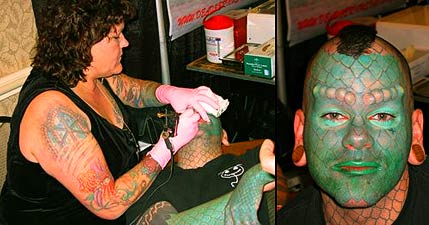

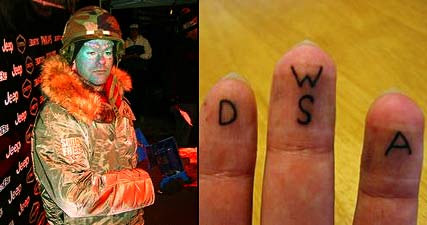

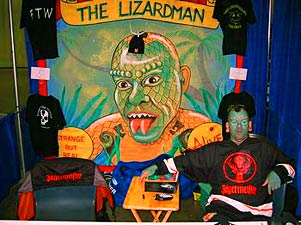
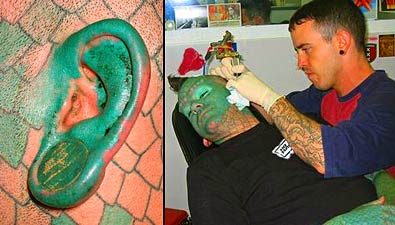
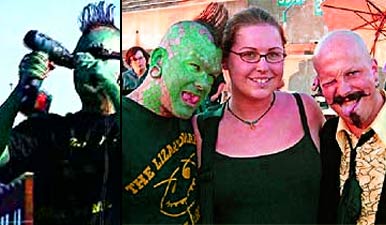

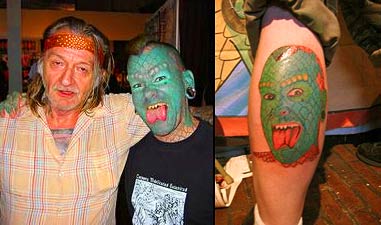

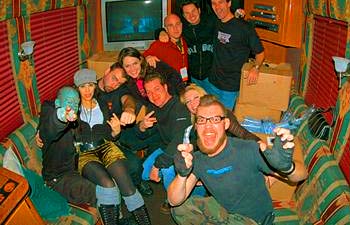
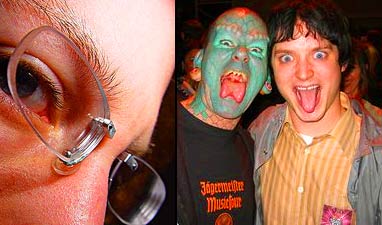









 Judaism has a long history of distaste for tattoos and piercings. It is my understanding that this stems from the Jewish concept that we are created b’tzelem Elokim (in the image of God) and that our bodies are to be viewed as a precious gift on loan from God, entrusted into our care, but not our personal property to do with as we choose. This distaste grew stronger with the Holocaust and the tattooing that was forced upon the Jews in the prison camps.
Judaism has a long history of distaste for tattoos and piercings. It is my understanding that this stems from the Jewish concept that we are created b’tzelem Elokim (in the image of God) and that our bodies are to be viewed as a precious gift on loan from God, entrusted into our care, but not our personal property to do with as we choose. This distaste grew stronger with the Holocaust and the tattooing that was forced upon the Jews in the prison camps. It is not prohibited to bury someone who has tattoos or body piercings in a Jewish cemetery. Although the Torah is interpreted by some to prohibit making a permanent tattoo on one’s body, those who violate this prohibition may still be buried in a Jewish cemetery and participate fully in all synagogue ritual.
It is not prohibited to bury someone who has tattoos or body piercings in a Jewish cemetery. Although the Torah is interpreted by some to prohibit making a permanent tattoo on one’s body, those who violate this prohibition may still be buried in a Jewish cemetery and participate fully in all synagogue ritual. “After an unfortunate tragedy where a close modified friend of mine committed suicide, his family was allowed to bury him in an orthodox Jewish cemetery. He was practically fully suited in tattoos and wore three earrings in each earlobe. At the funeral service I spoke at length with the orthodox rabbi who was performing the service about Jews and body modification. He told me that these misconceptions were not only outdated, but any Jew who believed in them was not following the ways of God. Jews are a very accepting and understanding people. Who are we to judge one for intentionally changing one’s body to fulfill their own desires?”
“After an unfortunate tragedy where a close modified friend of mine committed suicide, his family was allowed to bury him in an orthodox Jewish cemetery. He was practically fully suited in tattoos and wore three earrings in each earlobe. At the funeral service I spoke at length with the orthodox rabbi who was performing the service about Jews and body modification. He told me that these misconceptions were not only outdated, but any Jew who believed in them was not following the ways of God. Jews are a very accepting and understanding people. Who are we to judge one for intentionally changing one’s body to fulfill their own desires?” Deliberate, permanent disfigurement of the body would be prohibited. But such practices as ear piercing and cosmetic surgery (such as elective rhinoplasty) are not prohibited. The purpose of cosmetic surgery is to make the body more beautiful, not to disfigure it. (from
Deliberate, permanent disfigurement of the body would be prohibited. But such practices as ear piercing and cosmetic surgery (such as elective rhinoplasty) are not prohibited. The purpose of cosmetic surgery is to make the body more beautiful, not to disfigure it. (from  What puzzles and disturbs me is the quote from a rabbi stating that such practices as ear piercing and plastic surgery(1) are not prohibited because they are meant to beautify and not to disfigure. Who is to say that the purpose of my body modifications are not to make the body more beautiful? Is this for a rabbi to decide? I believe that the decision of what makes my body more beautiful is my own. Why is plastic surgery regarded as acceptable and other forms of body modification are not? What about circumcision which is a permanent modification? Who makes those decisions?
What puzzles and disturbs me is the quote from a rabbi stating that such practices as ear piercing and plastic surgery(1) are not prohibited because they are meant to beautify and not to disfigure. Who is to say that the purpose of my body modifications are not to make the body more beautiful? Is this for a rabbi to decide? I believe that the decision of what makes my body more beautiful is my own. Why is plastic surgery regarded as acceptable and other forms of body modification are not? What about circumcision which is a permanent modification? Who makes those decisions? Circumcision is also becoming a challenged ritual within Judaism as more and more Jews regard this practice as a social choice. This is a major body modification and disfigurement to a small child that is not given the choice to modify. It is also common practice among non-Jews to circumcise a male newborn penis, and this practice is not specifically Jewish, though it is common practice among Jews specifically. For more information on the complex issue regarding facts and myths of Jewish ritual circumcision, I invite you to visit
Circumcision is also becoming a challenged ritual within Judaism as more and more Jews regard this practice as a social choice. This is a major body modification and disfigurement to a small child that is not given the choice to modify. It is also common practice among non-Jews to circumcise a male newborn penis, and this practice is not specifically Jewish, though it is common practice among Jews specifically. For more information on the complex issue regarding facts and myths of Jewish ritual circumcision, I invite you to visit  For many people, conscious modification has become a way for them to take ownership of the beauty of their own bodies. For a very long time I felt uncomfortable in my own body. I was too fat, too short, my breasts were droopy — I could come up with a list a mile long. I discovered through modification that I loved my own body more when I got to choose what was happening to it. I would not knowingly disfigure my body. I intend to beautify it at my discretion. I am not the only one and I am far from the only modified Jew. By choosing to tattoo my body, I also feel that I am reclaiming this ritual for beauty rather than the hate and disrespect that was the intent of the Nazis forcibly tattooing the Jews during the holocaust.
For many people, conscious modification has become a way for them to take ownership of the beauty of their own bodies. For a very long time I felt uncomfortable in my own body. I was too fat, too short, my breasts were droopy — I could come up with a list a mile long. I discovered through modification that I loved my own body more when I got to choose what was happening to it. I would not knowingly disfigure my body. I intend to beautify it at my discretion. I am not the only one and I am far from the only modified Jew. By choosing to tattoo my body, I also feel that I am reclaiming this ritual for beauty rather than the hate and disrespect that was the intent of the Nazis forcibly tattooing the Jews during the holocaust. My Judaism and my body modification go hand in hand for me. They are both part of who I am and how I represent myself. I am a tattooed Jew. I am proud of both of these facets of my life. I am not ashamed to go to Shul and I am not afraid of the questions. What I dislike is the assumption that I am not as good a Jew because of my modifications. I completely disagree. What I dislike is the prejudice my own Jewish people bestow upon me, and others, for choosing to reclaim the ancient art of body modification. This in itself does not convey the Judaism of acceptance that has always been expressed to me in Shul. I believe this inter-judaic prejudice stems from a sociological prejudice thinly veiled by a misunderstood religious excuse.
My Judaism and my body modification go hand in hand for me. They are both part of who I am and how I represent myself. I am a tattooed Jew. I am proud of both of these facets of my life. I am not ashamed to go to Shul and I am not afraid of the questions. What I dislike is the assumption that I am not as good a Jew because of my modifications. I completely disagree. What I dislike is the prejudice my own Jewish people bestow upon me, and others, for choosing to reclaim the ancient art of body modification. This in itself does not convey the Judaism of acceptance that has always been expressed to me in Shul. I believe this inter-judaic prejudice stems from a sociological prejudice thinly veiled by a misunderstood religious excuse. My family ignores it. Don’t ask, don’t tell — sound familiar? — but still love and respect me as who I am. My family’s beliefs are those of conservative Jews and I respect them for that. However, I follow more of a Reconstructionist view. Reconstructionists define Judaism as the evolving religious civilization of the Jewish people and most Jewish people, including Reconstructionists, no longer accept its binding authority. While Reconstructionists are lovers of tradition and support community celebration of the Jewish sacred year and life-cycle events, we also believe that the face of the Jewish community is changing and that individuals have the right to adapt Jewish tradition to new circumstances. That doesn’t make us any less Jewish than those who live by Conservative or Orthodox law (although there would be plenty of argument within Judaism about this).
My family ignores it. Don’t ask, don’t tell — sound familiar? — but still love and respect me as who I am. My family’s beliefs are those of conservative Jews and I respect them for that. However, I follow more of a Reconstructionist view. Reconstructionists define Judaism as the evolving religious civilization of the Jewish people and most Jewish people, including Reconstructionists, no longer accept its binding authority. While Reconstructionists are lovers of tradition and support community celebration of the Jewish sacred year and life-cycle events, we also believe that the face of the Jewish community is changing and that individuals have the right to adapt Jewish tradition to new circumstances. That doesn’t make us any less Jewish than those who live by Conservative or Orthodox law (although there would be plenty of argument within Judaism about this). I think that the belief that body modification is prohibited by the Torah is antiquated, just as other Biblical laws are (and have thus been adjusted to fit modern times). Judaism is evolving in some sects; no longer do we have to hide what may be seen as “against the Torah” to practice our faith. It is quite a relief to do so. If you choose to practice your faith, there are many ways to do so. When you are dealing with Orthodox, Reform, Reconstructionist and Conservative movements, we will not agree on each others interpretation of the Torah.
I think that the belief that body modification is prohibited by the Torah is antiquated, just as other Biblical laws are (and have thus been adjusted to fit modern times). Judaism is evolving in some sects; no longer do we have to hide what may be seen as “against the Torah” to practice our faith. It is quite a relief to do so. If you choose to practice your faith, there are many ways to do so. When you are dealing with Orthodox, Reform, Reconstructionist and Conservative movements, we will not agree on each others interpretation of the Torah. Body Modification is just as much a part of my life as my faith in Judaism. I believe that my modifications beautify my body and bring joy to my life. They do not take away from my faith in God. My personal practice allows me to be who I am, and I wouldn’t have it any other way.
Body Modification is just as much a part of my life as my faith in Judaism. I believe that my modifications beautify my body and bring joy to my life. They do not take away from my faith in God. My personal practice allows me to be who I am, and I wouldn’t have it any other way. Liz Polay-Wettengel (iam:TattooedRedhead) is an executive general manager in Boston Massachusetts where she lives with her husband and two cats. She has a professional background in the music business and writes for several online blogs. Liz has been an active member of the IAM BME community since 2000 and currently runs the membership sponsorship forum and the
Liz Polay-Wettengel (iam:TattooedRedhead) is an executive general manager in Boston Massachusetts where she lives with her husband and two cats. She has a professional background in the music business and writes for several online blogs. Liz has been an active member of the IAM BME community since 2000 and currently runs the membership sponsorship forum and the 
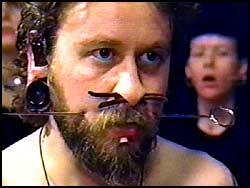
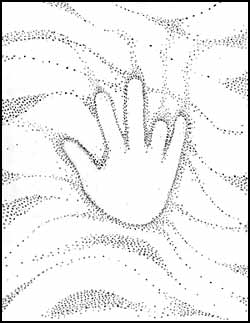





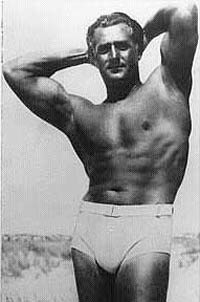


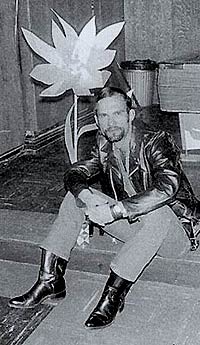



 Blake’s book, A Brief History of the Evolution of Body Adornment in Western Culture: Ancient Origins and Today is available from his website,
Blake’s book, A Brief History of the Evolution of Body Adornment in Western Culture: Ancient Origins and Today is available from his website,  The grandson of dental surgeon, noted socialite, and traveller Dr. Naomi Coval, Blake Andrew Perlingieri was inspired by his grandmother’s travels to remote tribal areas in the early to middle parts of the 20th century.
The grandson of dental surgeon, noted socialite, and traveller Dr. Naomi Coval, Blake Andrew Perlingieri was inspired by his grandmother’s travels to remote tribal areas in the early to middle parts of the 20th century.








